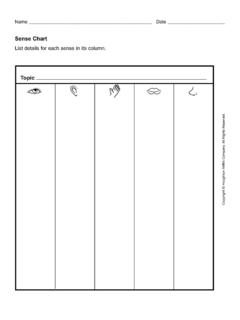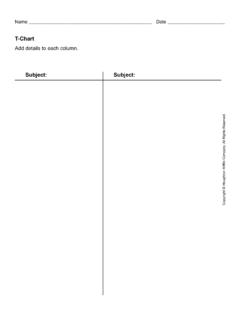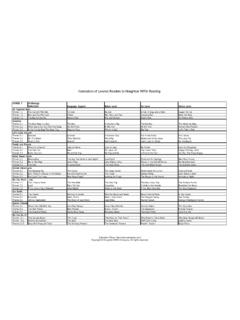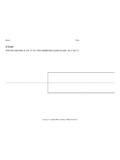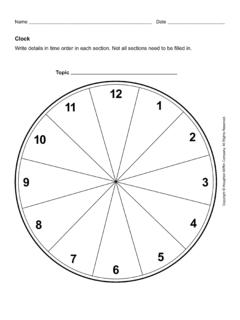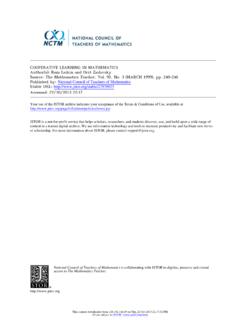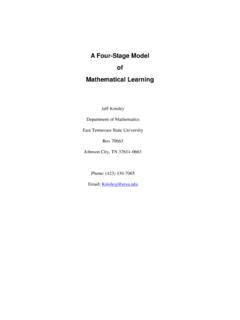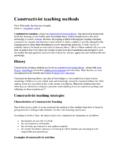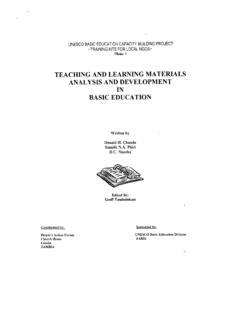Transcription of Vocabulary Strategies for the Mathematics …
1 Dr. David ChardLanguage and Vocabulary Consultant for Houghton Mifflin Math and Professor of Reading, University of Oregonocabulary knowledge is as essential to learningmathematics as it is to learning how to read. In language arts, mathematical words conjure up graphicrepresentations of the objects they label. But when itcomes to abstract mathematical concepts, wordsdescribe activities or relationships that often lack avisual counterpart. Yet studies show that childrengrasp the idea of quantity, as well as other relationalconcepts, from a very early age (Dehaene, 1997). As children develop their capacity for understanding,language, and its Vocabulary , becomes a vital cognitive link between a child s natural sense of number and order and conceptual learning .
2 Children learn Mathematics best by using it, andunderstanding the language of math gives studentsthe skills they need to think about, talk about, andassimilate new math concepts as they are example, as students develop conditional knowl-edge, knowing how to label and define objects suchas the difference between triangles, rectangles, andpolygons is essential to manipulating those language of math, in this case, is critical to helpingchildren develop the means to acquire new concepts. LET S TALK NUMBERS: THE IMPORTANCE OFTEACHING STUDENTS THE LANGUAGE OF MATHEMATICSW hile young students learn how to do math, theymust also learn how to articulate what they arelearning. Children must learn to recognize andanswer why questions in order to develop problem-solving skills.
3 And for teachers to accurately assessstudent progress, children first need to acquire themeans of explaining how they solve problems aswell as what concepts might not be clear to national legislation, such as the No ChildLeft BehindAct, increases pressure on school dis-tricts to ensure Adequate Yearly Progress for everyelementary student, regardless of their puts a premium on high-stakes standardizedtests administered at the end of each school only through frequent classroom-based assessments can teachers get timely feedback aboutVVocabulary Strategies for the Mathematics Classroomstudent progress. A well-designed Mathematics program should enable teachers to accurately assesshow well students are learning new content at theend of each lesson, and target interventions whenneeded.
4 Vocabulary knowledge and ensuring thatstudents learn, review, and use it makes problemsolving on high-stakes assessments accessible. MAKE Vocabulary KNOWLEDGE A PART OF EVERY LESSONV ocabulary Strategies for the math classroom aresimilar to those used in language-arts must know where in the curriculum tointroduce Vocabulary words, and when and how tohelp students make key connections that build onprior knowledge. Additional support may be neededto help non-English-speaking students. An effectivemathematics program should therefore build Vocabulary development into lesson content,assessments, and intervention modules that targeta wide range of student needs. To ensure that students are assimilating and using vocabularyknowledge essential to learning Mathematics , aneffective Mathematics curriculum should includethese simple Strategies in every lesson: Preteach Mathematics Vocabulary Model Vocabulary when teaching new concepts Use appropriate labels clearly and consistently Integrate Vocabulary knowledge in Mathematics VOCABULARYWhen and how should explicit Vocabulary instructionbe integrated into the Mathematics curriculum?
5 Preteaching Vocabulary in the Mathematics classroom removes cognitive barriers that prevent children from grasping new content. When taughtonly at point-of-use, Vocabulary words are oftenlost or misunderstood as elementary mathematicsstudents focus on learning new procedures. Bypreparing students with background information such as Vocabulary at the start of a new lesson,they are better equipped to put that information touse. The lesson then serves to reinforce new wordsthat stand for concepts as they are learned. Preteaching math Vocabulary also ensures that students learn and review essential words andexpressions long before they turn up on formativeand summative FORTHE Mathematics CLASSROOMV ocabulary CardsStudent Book, grade 2, page 260 Student Book, grade 4, page 486 and 487 MODEL Vocabulary WHEN teaching NEW CONCEPTS As new concepts are being introduced, teachersshould model Vocabulary words using appropriateproblems as examples.
6 Children need many exemplarsas they learn to apply unfamiliar words to veryabstract concepts. When modeling Vocabulary , it isimportant to use examples that children can see andmanipulate as well as discuss and write about. A goodmathematics program should also use culturally relevantexamples to illustrate math Vocabulary in organizerscan help childrengrasp an under-standing of math-ematical termsand their relationto one canhelp students distill word rootsthat provide contextual cluesto their shouldmodel Vocabulary with illustrative, precise examplesand attempt to engage students in conversationusing appropriate language. USE APPROPRIATE LABELS CLEARLY AND CONSISTENTLYIn the past, unconventional methodologies haveabandoned the teaching of standard mathematicsterminology in favor of inventive words or phrasescreated as scaffolding to help children grasp concepts.
7 While this might seem to activate children to do Mathematics , it often deprives them of the words they need to communicate what they are learning inrelevant ways. Mathematical language is used andunderstood around the world, and conventionalmathematics Vocabulary gives young learners themeans of communicating those concepts universally. The teacher s role in planning a hands-on mathematical task is to make sure their students are processing the right information. To ensure this,children need to be given appropriate vocabularywords to describe and reinforce the mathematicalconcepts and functions they are learning . An effectivemathematics curriculum should use these labels consistently. For example, when teaching reciprocals, it is important that children learn the word reciprocals to describe the concept.
8 If the conceptis discussed as flipping fractions upside-down without using the mathematical label, students missthe opportunity to connect the right vocabularyword with the concept as they are learning it. Student Book, grade 2, page 267 Student Book, grade 6, page 132 INTEGRATE Vocabulary KNOWLEDGE IN ASSESSMENTS Vocabulary should be placed strategically in questionsto reinforce Vocabulary knowledge along with conceptual knowledge. A goal of quality assessmentmust be to remedy whatever learning errors occur atthe time (Guskey, 2003), and assessing vocabularyknowledge is intrinsic to this process. Teachers shouldbe careful to review Vocabulary when it is used in adifferent context, so kids don t miss the connectionsas they are being made.
9 One obvious goal of reinforcing universal usage andbuilding fluency with mathematical concepts is toprepare students to do well on standardized who score poorly on tests often do sobecause they have difficulty reading and understandingthe problems presented. To promote conceptual under-standing and problem solving, lessons shouldinclude a focus on the mathematical Vocabulary and comprehension skills students need to acquirein order to read and interpret problems consistently using the labels for models andmanipulatives that are commonly found on tests intheir own lessons, teachers can ensure that studentsare well prepared for test taking. When effectivevocabulary instruction is built into a mathematicscurriculum, student achievement is likely to improveon Mathematics assessments.
10 More importantly, as children develop mathematicslanguage, they learn to communicate and share universal mathematical concepts and operations with their peers and others (Cobb, 1998). Vocabularyknowledge provides young learners with a Mathematics foundation they can apply and build on in and out of the classroom. REFERENCESB utterworth, B. (1999).The Mathematical York: , P., and Bowers, J. (1999). Cognitive and situatedlearning perspectives in theory and practice. Educational Researcher, 28 (2), 4 , S. (1997). The Number Sense: How the MindCreates : Oxford University , (2003). How classroom assessmentsimprove learning . Educational Leadership, 60 (5), 6 et al. (2001). Adding It Up: Helping ChildrenLearn , : NationalAcademies 2003 by Houghton Mifflin Company.
